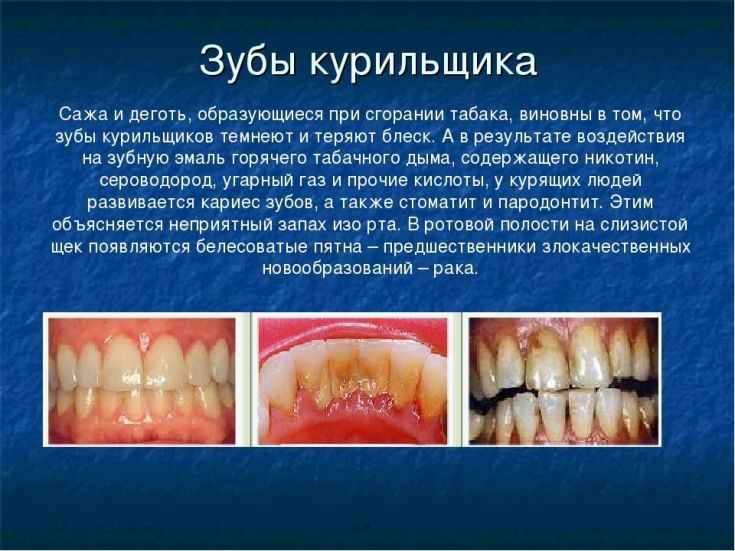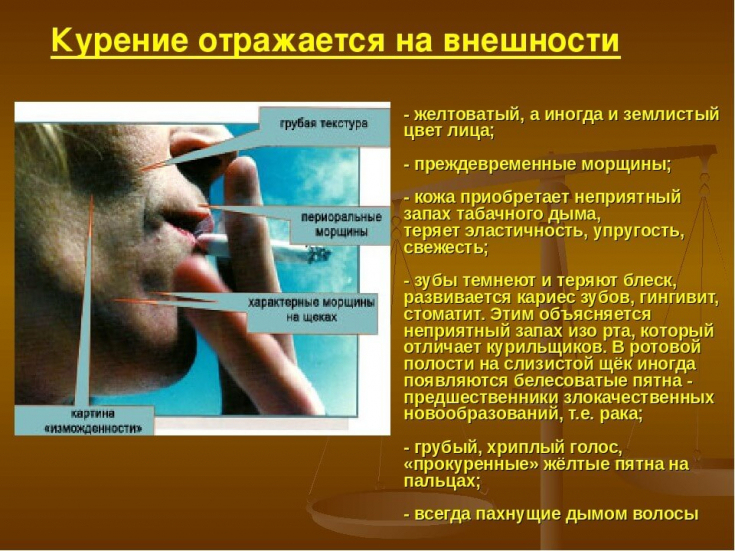Smoking − one of the urgent social and medical problems of our time, the cause of many serious diseases (oncological, cardiovascular, respiratory, etc.).
Smoking prevalence remains at a fairly high level, with an average of 40.1% of men and 8.9% of women smoking, or nearly a quarter of the adult population.
Find out in the article on estet-portal.com how detrimental smoking can be to the condition organs and tissues of the oral cavity.
- Smoking and oral health
- Components of tobacco smoke that cause oral diseases
- Prevention of oral diseases due to tobacco smokingand
Smoking and oral health
The harmful effects of smoking are well known to doctors of various specialties, but few take into account that smoking causes negative consequences for the oral cavity, because the mucous membrane of the oral cavity and periodontal tissues are the first to be hit by a harmful factor.
Follow us on Instagram!
Organs and oral tissues, oral fluid − this is the site of primary contact of the smoker's body with toxic and carcinogenic substances that are part of tobacco smoke.
In a review of available publications on the association of smoking with oral diseases, a significant effect of smoking on the occurrence of dental caries, periodontal and oral mucosal diseases, as well as cases of rejection of dental implantss.
Smokers are more likely to experience halitosis (bad breath), specific hard plaque formation on the teeth ("smoker's plaque"), dry mouth and taste inversions.
Components of tobacco smoke that cause oral diseases
What substances can adversely affect the tissues of the oral cavity and the human body as a whole during smoking?
Tobacco smoke consists of: ammonia, carbon monoxide, hydrogen cyanide, hydrogen sulfide, argon and methane.
Ingredients threatening to health include: aggressive aldehydes (acrolein and acetaldehyde), acetone, benzene, butylamine, dimethylamine, DDT, ethylamine, methylamine, formaldehyde, hydroquinone, methyl alcohol, pyridine and compounds nickel.
And this is not a complete list of chemicals in the composition of tobacco smoke and tobacco tar, there are about 2000 of them.
Botulinum toxin use in oral surgery
To fully appreciate the effect of chemicals in tobacco smoke and tobacco tar, it should be taken into account that the oral mucosa has high penetrating power.
Even more penetrating is the special connective epithelium of the gingival sulcus, with damage to which begins destruction of periodontal tissues.
Numerous epidemiological studies have shown that the prevalence of periodontal disease among smokers is much higher than among non-smokers, and the severity of clinical manifestations and the prognosis of consequences directly depend on the number of cigarettes smoked daily and the duration of the bad habit (more obvious after 10 years of smoking).

Smoking has also been found to have a negative impact on oral hygiene, as evidenced by the higher values of hygiene indices in smokers compared to non-smokers.
Smokers more intensively form hard dental deposits, which injure the gingival margin and are a retention point for the formation of a mature biofilm, the most pathogenic for hard tooth tissues and periodontal tissues.
Crowns for teeth: which ones are better to install and why
Prevention of diseases of the oral cavity in tobacco smoking
In view of the foregoing, dentists should educate patients on a daily basis about the negative effects of smoking on oral tissues, encouraging them to complete cessation of smoking.
Alternative methods may be offered to patients who are not ready to quit smoking.

Thus, in clinical studies in favor of nicotine-containing products, including electronic cigarettes, we are talking about a progressive improvement in periodontal health, as well as general oral health, provided the rejection of conventional cigarettes and the transition to electronic.
It was the combination of the harmful effects of the components of tobacco smoke and nicotine that had a more negative effect on periodontal tissues compared to the effect of nicotine alone in electronic cigarettes.
Electronic cigarettes have somewhat reduced the typical negative effects of smoking, as well as alleviating the severity of smoking-related oral diseases.
Dental floss: how to choose and use it correctly
Similar results were obtained during a comparative analysis of the effect of tobacco smoke and aerosol from a tobacco heating system on organotypic human gingival epithelial cells.
In particular, under the influence of high concentrations of tobacco smoke the gingival epithelium was severely damaged, along with the process of keratinization, manifestations of apoptosis, karyorrhexis, pycnosis appeared, while aerosol exposure of the system heating tobacco caused minor changes in the epithelium: sporadic atrophy, loss of a clear distinction between the layers.
Enamel discoloration: a serious wake-up call
Research confirms that aerosol from tobacco or e-cigarette heating systems has much less effect on oral tissues compared to cigarette smoke.







Add a comment